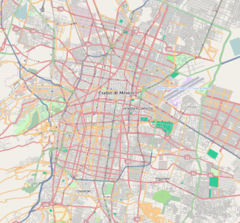UAM-Azcapotzalco metro station
Mexico City metro station From Wikipedia, the free encyclopedia
UAM-Azcapotzalco (ⓘ; formerly Azcapotzalco) is a metro station in northern Mexico City, located in the Azcapotzalco borough, along Line 6. In 2019, the station had an average ridership of 8,076 passengers per day.[2]
| STC rapid transit | |||||||||||
 | |||||||||||
| General information | |||||||||||
| Location | Mexico City Mexico | ||||||||||
| Coordinates | 19°29′28″N 99°11′11″W | ||||||||||
| Operated by | Sistema de Transporte Colectivo (STC) | ||||||||||
| Line(s) | (El Rosario - Martín Carrera) | ||||||||||
| Platforms | 2 side platforms | ||||||||||
| Tracks | 2 | ||||||||||
| Construction | |||||||||||
| Structure type | Underground | ||||||||||
| Other information | |||||||||||
| Status | In service | ||||||||||
| History | |||||||||||
| Opened | 21 December 1983 | ||||||||||
| Previous names | Azcapotzalco | ||||||||||
| Passengers | |||||||||||
| 2023 | 2,448,202[1] 15.77% | ||||||||||
| Rank | 144/195[1] | ||||||||||
| Services | |||||||||||
| |||||||||||
| |||||||||||
General information
Summarize
Perspective
Azcapotzalco was opened on 21 December 1983, as part of the first stretch of Line 6, going from El Rosario to Instituto del Petróleo.[3]
The station serves the Reynosa Tamaulipas, San Andrés and San Marcos neighborhoods. It is also close to Azcapotzalco's downtown and city hall as well as to the Universidad Autónoma Metropolitana Azcapotzalco campus.
Name and pictogram
The station was originally named Azcapotzalco. This was decided due to the fact that Metro Azcapotzalco was the closest station to downtown Azcapotzalco and to the municipality's city hall.[4]
The station's pictogram depict an ant because Azcapotzalco's ancient meaning literally translates to "in the place of the anthills".[4]
Ridership
| Annual passenger ridership | |||||
|---|---|---|---|---|---|
| Year | Ridership | Average daily | Rank | % change | Ref. |
| 2023 | 2,448,202 | 6,707 | 144/195 | +15.77% | [1] |
| 2022 | 2,114,779 | 5,793 | 151/195 | +46.86% | [1] |
| 2021 | 1,439,985 | 3,945 | 157/195 | −19.74% | [5] |
| 2020 | 1,794,159 | 4,902 | 157/195 | −39.14% | [6] |
| 2019 | 2,947,847 | 8,076 | 166/195 | +0.44% | [2] |
| 2018 | 2,935,018 | 8,041 | 165/195 | −1.20% | [7] |
| 2017 | 2,970,709 | 8,138 | 164/195 | −2.89% | [8] |
| 2016 | 3,058,994 | 8,357 | 161/195 | −3.39% | [9] |
| 2015 | 3,166,394 | 8,675 | 147/195 | +11.71% | [10] |
| 2014 | 2,834,420 | 7,765 | 157/195 | +7.75% | [11] |
References
External links
Wikiwand - on
Seamless Wikipedia browsing. On steroids.


